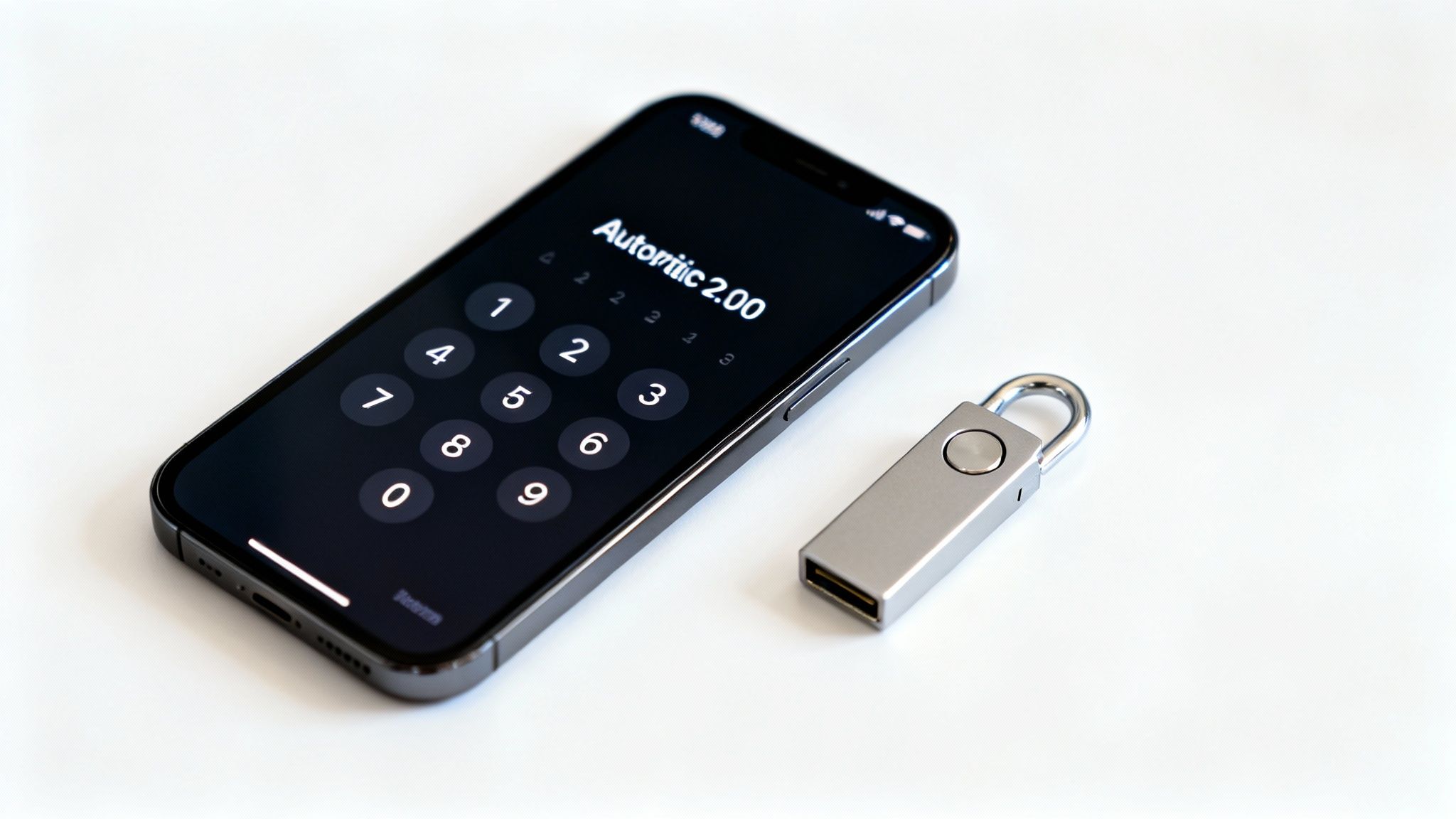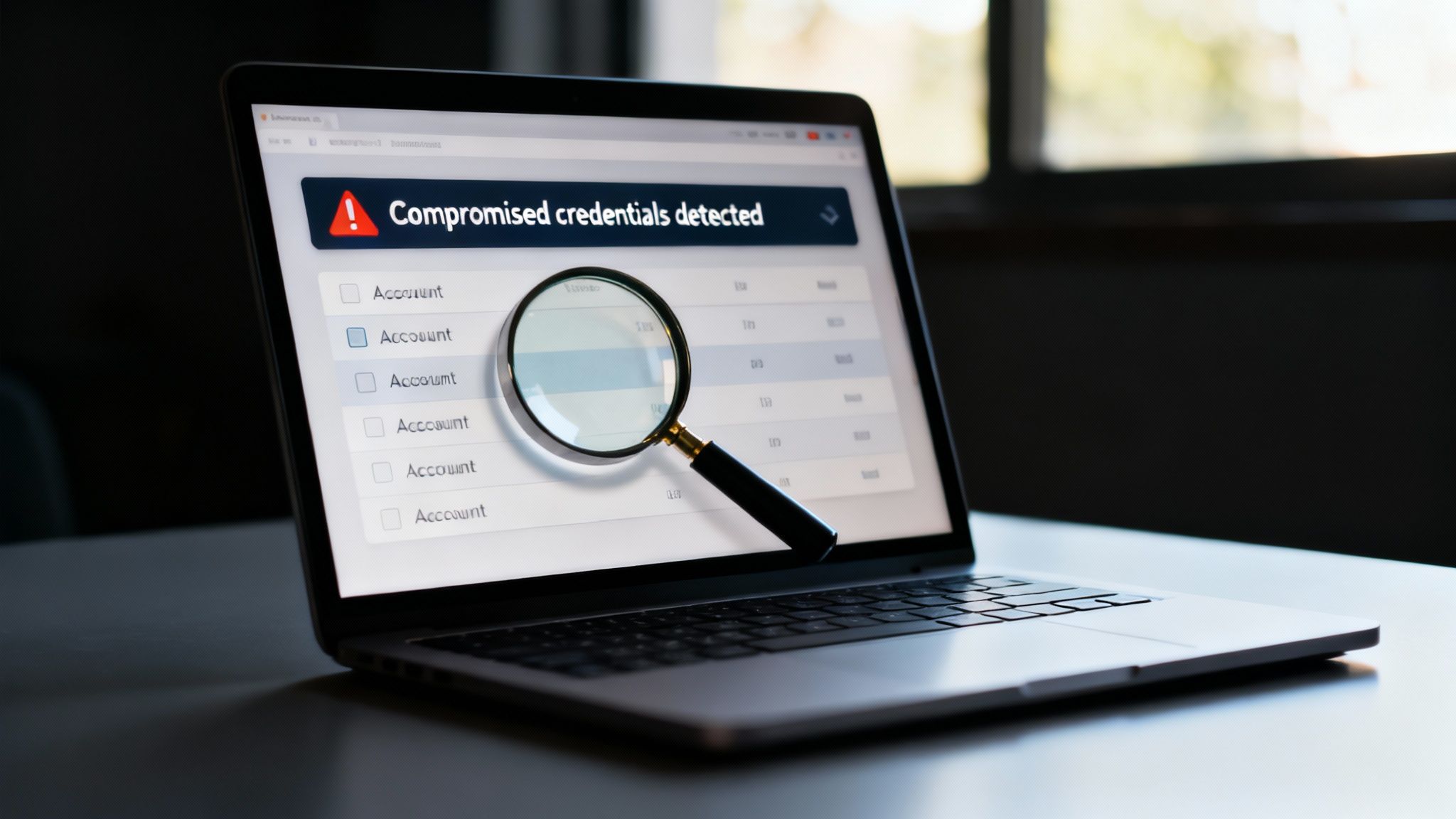In an era where a single data breach can expose millions of credentials, the strength of your passwords has never been more critical. While often seen as a minor inconvenience, they are the primary gatekeepers to your most sensitive personal and business information. Weak or reused passwords are the digital equivalent of leaving your front door unlocked, offering an open invitation to unauthorized access and potential compromise of client data, financial records, and proprietary information.
This guide moves beyond generic advice. We will provide a comprehensive roundup of the 10 most effective, actionable, and modern best practices for password management. These strategies are designed specifically for professionals and small to mid-sized businesses looking to establish a robust security posture.
You will learn how to implement a dedicated password manager, enable multi-factor authentication, and create enforceable password policies for your team. We will also cover crucial steps like auditing existing credentials, training users to recognize threats, and responding effectively when a breach occurs. Whether you're a law firm protecting confidential case files or a dental practice securing patient records, these practical steps will provide the framework you need to build a formidable defense against evolving cyber threats and protect your most valuable digital assets.
1. Use Strong, Unique Passwords for Each Account
The foundational rule of modern cybersecurity is using a distinct, complex password for every single account. This practice directly counters the most common method hackers use to gain unauthorized access: credential stuffing. When a data breach occurs at one company, attackers take the leaked email and password combinations and test them on other popular services like banking, email, and social media accounts. If you reuse passwords, a single breach can compromise your entire digital life.

Creating strong credentials is one of the most effective and straightforward best practices for password management a business can implement. A strong password isn't just about complexity; it’s about length and randomness, making it difficult for brute-force software to crack.
How to Implement This Practice
To effectively secure your accounts, focus on three core principles: length, complexity, and uniqueness.
- Length is Key: Aim for a minimum of 12-16 characters. Every additional character exponentially increases the time required to crack it.
- Mix It Up: A strong password includes a combination of uppercase letters, lowercase letters, numbers, and special symbols (e.g., !, @, #, $).
- Avoid Predictability: Never use personal information like birthdates, pet names, or common words and phrases. A password like
Password123!is easily guessed, whereasR$k9@zP#vB7qis not. - Embrace Passphrases: A memorable yet secure alternative is a passphrase, which is a sequence of random words. For example,
Correct!Horse9Battery$Stapleis both long and complex but can be easier for a user to remember than a random string of characters.
The most practical way to manage this is by using a password manager, which can generate and securely store these unique, complex passwords for you, eliminating the need to memorize them.
2. Implement a Dedicated Password Manager
Memorizing dozens of long, complex, and unique passwords is an unrealistic expectation for anyone. A dedicated password manager solves this problem by acting as a secure digital vault for all your credentials. This software generates, stores, and autofills passwords across devices, requiring you to remember only one strong master password to access everything.

Adopting a password manager is one of the most impactful best practices for password management because it automates security. It removes human error, such as the tendency to reuse weak passwords, and empowers users to adopt complex credentials without the burden of memorization. Tools like 1Password, Bitwarden, and Dashlane are widely used in both personal and professional settings for their robust encryption and user-friendly features.
How to Implement This Practice
Choosing and configuring a password manager correctly is crucial for maximizing its security benefits.
- Select a Reputable Provider: Choose a tool with a strong reputation and transparent security policies. Look for providers that undergo regular third-party security audits.
- Create a Strong Master Password: Your master password is the key to your entire vault, so make it a long, unique passphrase that you have never used elsewhere.
- Enable Two-Factor Authentication (2FA): Add an extra layer of security to the password manager itself. This ensures that even if your master password is compromised, no one can access your vault without a second verification step.
- Utilize Browser Extensions and Mobile Apps: Install the password manager's extensions on your web browsers and apps on your mobile devices for seamless password generation, saving, and autofilling.
- Configure Emergency Access: Set up a trusted contact who can request access to your vault in an emergency. This is a critical recovery feature for both business and personal accounts.
By centralizing credential management, you not only improve security but also boost productivity by simplifying the login process for all your essential services.
3. Enable Two-Factor Authentication (2FA) on Critical Accounts
Even the strongest password can be compromised in a sophisticated phishing attack or data breach. Two-factor authentication (2FA) acts as a critical second layer of defense, ensuring that even if a criminal steals your password, they still can't access your account. It works by requiring a second form of verification beyond just your password, such as a code from your phone or a fingerprint scan.

Implementing 2FA is one of the most impactful best practices for password management you can adopt. It drastically reduces the risk of unauthorized access to sensitive business data and personal information. For a deeper dive into enhancing security beyond just passwords, explore strategies like Multi-Factor Authentication (MFA).
How to Implement This Practice
Effectively rolling out 2FA involves prioritizing critical accounts and choosing the right verification methods for your security needs.
- Prioritize Key Accounts: Start by enabling 2FA on your most valuable accounts, including primary email, financial institutions, cloud storage, and any system containing client data.
- Choose Secure Methods: While SMS codes are better than nothing, authenticator apps like Google Authenticator or Authy are more secure as they are not vulnerable to SIM-swapping attacks.
- Use Hardware Keys for Maximum Security: For ultimate protection on high-value accounts, use a physical security key like a YubiKey. This requires the physical device to be present to log in, making remote attacks nearly impossible.
- Store Recovery Codes Safely: When you set up 2FA, you will receive backup codes. Store these securely in your password manager or an encrypted vault, never in plain text on your computer.
This practice is a fundamental part of modern network security best practices and should be standard procedure for all critical systems. You can learn more about implementing robust network security measures to further protect your business.
4. Regularly Audit and Update Passwords
Static passwords are a liability. Regularly auditing and updating credentials is a proactive security measure that closes vulnerabilities over time. This practice involves systematically reviewing password usage across an organization, identifying weak or reused passwords, and updating them to maintain a strong security posture. It’s a crucial defense against threats like credential stuffing and access from compromised accounts that may have been exposed in third-party data breaches.
Conducting periodic password health checks is one of the most impactful best practices for password management you can adopt. Modern password managers often include built-in security dashboards that automate much of this process, making it easy to spot and fix potential risks before they can be exploited. This ongoing maintenance ensures your first line of defense remains robust.
How to Implement This Practice
A systematic audit process helps you stay ahead of potential threats. The goal is to make password reviews a regular, manageable habit rather than a chaotic reaction to a security incident.
- Schedule Regular Audits: Set a recurring calendar reminder to review password health on a quarterly basis. Consistency is key to preventing security gaps.
- Utilize Audit Tools: Leverage the built-in features of your password manager. Tools like Dashlane and 1Password offer security scores, detect reused or weak passwords, and provide dark web monitoring to alert you if your credentials appear in a breach.
- Prioritize Critical Accounts: At a minimum, change the passwords for your most sensitive accounts, such as primary email, financial institutions, and core business software, at least once a year.
- Act on Breach Notifications: Immediately update the password for any account flagged in a data breach. You can check for compromised credentials using services like Have I Been Pwned. This simple step prevents attackers from using leaked information to access your other accounts.
5. Avoid Common Password Pitfalls and Anti-Patterns
Just as important as creating strong passwords is actively avoiding the common mistakes, or "anti-patterns," that make them vulnerable. Attackers often rely on predictable human behavior to guess credentials, using software that tests for common substitutions, keyboard walks, and sequential numbers. Recognizing and steering clear of these pitfalls is a defensive strategy that closes the door on the most frequent and low-effort attack vectors.
Understanding these common failure points is a cornerstone of effective best practices for password management. By training yourself and your team to spot and avoid these bad habits, you significantly reduce your attack surface and force malicious actors to work much harder to compromise an account, often causing them to move on to easier targets.
How to Implement This Practice
The key is to think like an attacker and eliminate any predictable elements from your credentials. This involves being mindful of the shortcuts and patterns people naturally gravitate towards.
- Steer Clear of Personal Data: Never use information that can be found on your social media or company website, such as your birthdate, pet’s name, or city of residence (e.g.,
Fluffy1998). - Avoid Keyboard Patterns: Passwords like
qwerty123orasdfghjklare among the first that automated cracking tools will try. Avoid any sequential or adjacent key combinations. - Beware of Simple Substitutions: Swapping letters for similar-looking numbers or symbols (e.g.,
P@ssw0rd1instead ofPassword1) is a well-known trick that modern cracking software easily accounts for. - Don't Use Predictable Variations: Avoid using a single base password and making minor changes for different sites, such as
MyDogBuddy1!for email andMyDogBuddy2!for banking. A breach of one exposes the pattern for all.
6. Secure Password Storage and Protection
Generating strong, unique passwords is only half the battle; storing them securely is equally critical. Secure password storage involves using encrypted tools and methods to protect your credentials from unauthorized access. This practice ensures that even if a device or file containing your passwords is stolen or compromised, the information remains unreadable and unusable to attackers. Without proper protection, a list of even the strongest passwords becomes a master key for cybercriminals.
Implementing encrypted storage is one of the most vital best practices for password management because it protects the central repository of your digital keys. Modern password managers like Bitwarden or 1Password use a "zero-knowledge" architecture, meaning even the service provider cannot access your stored credentials, providing a powerful layer of security and privacy.
How to Implement This Practice
Properly securing your password vault requires a multi-layered approach that combines strong tools with cautious user behavior.
- Use a Reputable Password Manager: Choose a tool with end-to-end encryption. Options like Bitwarden, 1Password, and LastPass are built on secure, audited cryptographic models designed specifically for this purpose.
- Create a Strong Master Password: Your master password is the key to your entire vault. Make it a long, complex passphrase that you have never used anywhere else and can remember without writing it down.
- Enable Full-Disk Encryption: Ensure the devices where your password manager is installed (laptops, phones) have full-disk encryption enabled, such as BitLocker for Windows or FileVault for macOS. This protects your vault if the physical device is lost or stolen.
- Avoid Plain Text Storage: Never store passwords in unencrypted documents, spreadsheets, or notes. This is the equivalent of leaving your keys under the doormat for anyone to find.
7. Implement Password Policies and Governance
Beyond individual user habits, a formalized set of rules is essential for organizational security. Implementing password policies and governance means establishing and enforcing clear standards for how credentials are created, used, and managed across your entire business. This approach shifts password security from a suggestion to a mandatory, auditable practice that reduces systemic risk.
Creating a clear framework is one of the most critical best practices for password management because it ensures every team member adheres to the same high security standards. A well-designed policy, often based on guidelines from organizations like the National Institute of Standards and Technology (NIST), provides a defensible and consistent security posture that protects sensitive company data.
How to Implement This Practice
Effective governance balances robust security with practical usability, ensuring policies are followed rather than circumvented.
- Adopt Modern Standards: Base your policies on current guidelines like NIST SP 800-63B. Prioritize password length (e.g., a minimum of 12-15 characters) over arbitrary complexity rules like requiring specific symbol types.
- Eliminate Forced Expiration: Avoid mandatory, time-based password changes. Instead, trigger a password reset only when there is evidence of a compromise, such as a known breach or suspicious login activity.
- Screen Against Breached Passwords: Actively block users from choosing passwords that are known to have been compromised in previous data breaches. Many identity management systems offer this feature.
- Educate and Empower: Clearly communicate the "why" behind your policies. When employees understand the risks, they are more likely to comply. Provide tools like a company-wide password manager to make it easy for them to follow the rules.
8. Use Secure Password Recovery and Account Recovery Methods
Even the most robust password is useless if a user forgets it and cannot regain access. Secure account recovery is a critical, often overlooked, component of a comprehensive security strategy. It establishes a reliable but fortified process for users to regain control of their accounts after losing a password or experiencing a compromise, preventing attackers from exploiting recovery mechanisms as a backdoor.
Implementing secure recovery is one of the most important best practices for password management, as it balances user accessibility with stringent identity verification. A weak recovery process, like easily guessable security questions, can undermine the strongest passwords. Services like Google and Apple provide multi-faceted recovery options, including backup codes, secondary email addresses, and trusted phone numbers, creating layered security.
How to Implement This Practice
To build a resilient recovery system, focus on diverse, secure, and regularly updated methods.
- Prioritize Recovery Codes: When available, use one-time recovery codes. Store them offline in a secure physical location, like a safe, separate from your password manager.
- Use a Dedicated Recovery Email: Assign a secondary email address exclusively for account recovery. This isolates the recovery channel from your primary, day-to-day email account. For added protection, you can explore the best email security solutions on gtcomputing.com to secure this crucial access point.
- Avoid Weak Security Questions: If you must use security questions, choose answers that are not publicly discoverable and treat them like secondary passwords.
- Regularly Review and Update: Schedule an annual review of all your recovery information (phone numbers, emails) across critical accounts to ensure it remains current and secure.
- Test Your Recovery Process: Don’t wait for an emergency. Periodically walk through the recovery process for a key account to ensure you understand it and that all methods work as expected.
9. Educate Users and Promote Security Awareness
Technical controls are only part of the solution; your employees represent the first and most critical line of defense. A comprehensive security awareness program is essential for turning this potential vulnerability into a powerful asset. By educating users on the importance of password security and how to recognize common threats like phishing and social engineering, you empower them to actively protect company data.
Investing in ongoing training is one of the most impactful best practices for password management because it addresses the human element of cybersecurity. Even the strongest password policy can be undermined by a single employee who falls for a phishing scam. Platforms like KnowBe4 and Proofpoint have built entire industries around this principle, demonstrating its effectiveness in reducing security incidents.
How to Implement This Practice
A successful security awareness program is continuous, engaging, and relevant. It should be integrated into your company culture rather than treated as a one-time event.
- Start at Onboarding: Introduce password policies and security expectations to all new employees from day one.
- Conduct Regular Training: Schedule quarterly or biannual refresher courses to keep security top-of-mind and cover new threats.
- Run Phishing Simulations: Use safe, controlled phishing tests to gauge user awareness and provide immediate, contextual feedback to those who click a malicious link.
- Make it Engaging: Use real-world (anonymized) examples of security incidents, interactive quizzes, and even gamification with rewards to make the training memorable.
- Create Security Champions: Appoint and train enthusiastic employees within different departments to act as local security advocates, answering questions and promoting best practices among their peers.
10. Monitor for Breaches and Respond to Compromised Credentials
Even the strongest passwords can be exposed in third-party data breaches. Proactive monitoring for these incidents is a critical layer of defense, allowing you to react swiftly before compromised credentials can be used against your business or personal accounts. This practice involves using specialized tools and services to scan for your information on the dark web and in publicly disclosed breach databases, ensuring you are alerted the moment a credential is leaked.

Actively monitoring for compromised accounts is one of the most important best practices for password management because it closes the gap between a breach occurring and your response. Many modern password managers like LastPass and Dashlane have built-in breach monitoring, and enterprise solutions like Azure AD Identity Protection automatically flag at-risk accounts. Having a clear incident response plan is vital for minimizing damage from a potential breach. For more information, you can learn more about how to prevent data loss.
How to Implement This Practice
To build a robust monitoring and response strategy, you need automated tools and a clear, actionable plan.
- Enable Breach Alerts: Turn on dark web monitoring and breach alert features within your password manager. These tools automatically cross-reference your stored credentials against known breach databases.
- Utilize Monitoring Services: For comprehensive protection, consider using one of the best dark web monitoring services to continuously scan for company domains, executive emails, and other sensitive assets.
- Establish an Incident Response Plan: When an alert is received, immediately change the password for the affected account. Next, enable multi-factor authentication if it is not already active.
- Review Account Activity: After securing the account, thoroughly check login history and recent activity for any unauthorized actions. Documenting your response is crucial for compliance and learning from the incident.
10-Point Password Management Comparison
| Practice | 🔄 Implementation Complexity | ⚡ Resource Requirements | ⭐ Expected Effectiveness | 📊 Ideal Use Cases | 💡 Key Advantage / Tip |
|---|---|---|---|---|---|
| Use Strong, Unique Passwords for Each Account | Low–Moderate, manual effort; 🔄🔄 | Low ⚡ | ⭐⭐⭐⭐ | Personal accounts, non-enterprise services | Use passphrases or a generator; avoid reuse |
| Implement a Dedicated Password Manager | Moderate, setup & onboarding; 🔄🔄🔄 | Moderate ⚡⚡ (subscription/devices) | ⭐⭐⭐⭐⭐ | Individuals, families, SMBs, enterprises | Pick audited provider, enable MFA on manager |
| Enable Two-Factor Authentication (2FA) on Critical Accounts | Low–Moderate per account; 🔄🔄 | Low–Moderate ⚡⚡ | ⭐⭐⭐⭐⭐ | Email, banking, admin, high-risk accounts | Prefer TOTP/hardware keys over SMS; store recovery codes |
| Regularly Audit and Update Passwords | Moderate–High, process-driven; 🔄🔄🔄 | Moderate ⚡⚡ (tools/automation) | ⭐⭐⭐⭐ | Organizations, critical accounts | Use manager audit & breach checks; audit quarterly |
| Avoid Common Password Pitfalls and Anti-Patterns | Low, policy/education; 🔄 | Low ⚡ | ⭐⭐⭐⭐ | All users and consumer accounts | Teach to avoid PII, patterns, obvious substitutions |
| Secure Password Storage and Protection | Moderate–High, technical controls; 🔄🔄🔄 | High ⚡⚡⚡ (vaults/HSMs) | ⭐⭐⭐⭐⭐ | Enterprises, shared secrets, regulated data | Use end-to-end encryption & zero-knowledge storage |
| Implement Password Policies and Governance | High, policy + enforcement; 🔄🔄🔄 | High ⚡⚡⚡ (IAM/tools/admin) | ⭐⭐⭐⭐ | Enterprises, compliance-driven orgs | Base policies on NIST; favor length over arbitrary rules |
| Use Secure Password Recovery and Account Recovery Methods | Moderate, careful design; 🔄🔄 | Moderate ⚡⚡ | ⭐⭐⭐⭐ | Critical accounts, enterprise support flows | Store recovery codes separately; test recovery processes |
| Educate Users and Promote Security Awareness | Moderate, ongoing program; 🔄🔄 | Moderate ⚡⚡ (training platforms/time) | ⭐⭐⭐⭐ | Organizations, onboarding & continuous learning | Make training interactive; run phishing simulations |
| Monitor for Breaches and Respond to Compromised Credentials | Moderate–High, detection + IR; 🔄🔄🔄 | Moderate–High ⚡⚡⚡ (services/SIEM/response) | ⭐⭐⭐⭐ | Enterprises, high-risk environments, IT teams | Enable breach alerts, rotate compromised credentials immediately |
Moving From Theory to Action: Your Next Steps in Password Security
We have journeyed through ten foundational pillars of modern digital defense, from the granular detail of crafting unique, complex passwords to the high-level strategy of implementing robust company-wide security policies. The path to mastering these concepts is not a destination but a continuous process of adaptation and diligence. Implementing these best practices for password management transforms your security posture from a passive, reactive stance into an active, resilient framework.
The core takeaway is that no single strategy is a silver bullet. True digital security is a layered defense system. A strong password, while essential, is fortified by two-factor authentication. A powerful password manager is only effective when coupled with regular audits and user education. Each practice we've discussed, from avoiding common pitfalls to monitoring for data breaches, acts as a distinct yet interconnected layer of protection for your sensitive information. For professionals in fields like law or healthcare, and for any small or mid-sized business, this multi-layered approach is not just a recommendation; it is a professional obligation to protect client data and maintain operational integrity.
Your Action Plan for Stronger Security
The sheer volume of information can feel overwhelming, but progress begins with a single, deliberate step. Instead of attempting to implement everything at once, focus on a phased approach that delivers immediate impact and builds momentum.
Here are your actionable next steps:
- Prioritize Your "Crown Jewels": Start by identifying your most critical accounts. This includes your primary business email, financial portals, cloud storage, and any systems containing sensitive client information. Apply the most stringent measures here first, such as enabling 2FA and creating new, unique passwords stored in a manager.
- Select and Deploy a Password Manager: This is the cornerstone of your entire strategy. Research and choose a password manager that fits your team's needs. Dedicate time this week to migrating your most important credentials into the vault. This single action automates many of the best practices for password management we've covered.
- Schedule Your First Security Audit: Block out one hour on your calendar next month. Use this time to review your password health report within your new manager, identify weak or reused passwords, and begin the process of updating them. Make this a recurring quarterly event.
- Initiate a Security Conversation: Whether you are a solo practitioner or a team leader, start a conversation about security awareness. Share this article or one key takeaway during your next team meeting. Fostering a culture where security is a shared responsibility is one of the most powerful defenses you can build.
Ultimately, strengthening your password management is an investment in business continuity and professional reputation. By moving from theoretical knowledge to practical application, you are not just preventing unauthorized access; you are building a more secure, efficient, and trustworthy operation. This proactive stance ensures you are prepared to navigate the digital threats of today while laying a secure foundation for the future.
Implementing a comprehensive security strategy can be complex. If you need expert guidance to deploy a password manager, establish security policies, or train your team on the best practices for password management, GT Computing is here to help. We translate complex IT requirements into practical, effective solutions that protect your business without disrupting your workflow.
Keep your business running without IT headaches.
GT Computing provides fast, reliable support for both residential and business clients. Whether you need network setup, data recovery, or managed IT services, we help you stay secure and productive.
Contact us today for a free consultation.
Call 203-804-3053 or email Dave@gtcomputing.com


